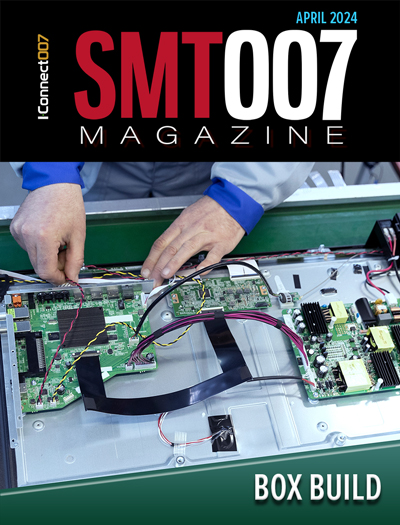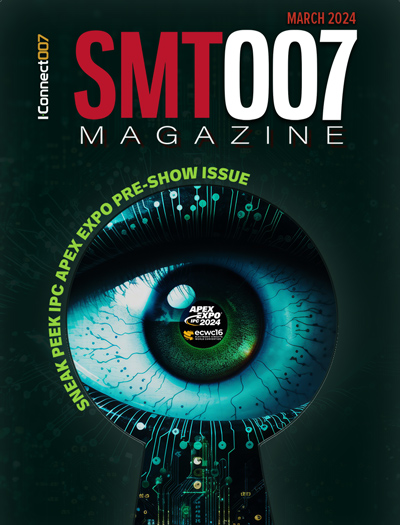-

- News
- Books
Featured Books
- smt007 Magazine
Latest Issues
Current Issue
Box Build
One trend is to add box build and final assembly to your product offering. In this issue, we explore the opportunities and risks of adding system assembly to your service portfolio.

IPC APEX EXPO 2024 Pre-show
This month’s issue devotes its pages to a comprehensive preview of the IPC APEX EXPO 2024 event. Whether your role is technical or business, if you're new-to-the-industry or seasoned veteran, you'll find value throughout this program.

Boost Your Sales
Every part of your business can be evaluated as a process, including your sales funnel. Optimizing your selling process requires a coordinated effort between marketing and sales. In this issue, industry experts in marketing and sales offer their best advice on how to boost your sales efforts.
- Articles
- Columns
Search Console
- Links
- Events
||| MENU - smt007 Magazine
Investigating Analytical Tools for Testing Cleanliness with Foresite's Eric Camden
April 19, 2018 | Patty Goldman, I-Connect007Estimated reading time: 23 minutes
At the West Penn SMTA Expo, I met Eric Camden, lead investigator at Foresite Inc. He was quite busy most of the day but towards the end, we found time for a chat. In the short time we talked, he taught me a great deal about fluxes and analytical tools for testing cleanliness.
Patty Goldman: Eric, Tell me a little bit about Foresite and yourself.
Eric Camden: Foresite is an analytical third-party testing lab that focuses on the process and all the materials that go into assembly. We do failure analysis as well as process qualification, process audits and optimization. We cover everything from incoming raw components to the final packaged product as it leaves the door. We have a long history of dealing with OEMs and CMs and looking at both the failure side of the process as well as the process qualification side. What we've learned in our 26 years is that everything matters. It's a cumulative process when it comes to building an assembly. We look at everything from the innerlayer of the PC fab all the way to the ESD bag that a board is put in on the way out the door.
Everything that comes in contact with an assembly has an opportunity to cause an issue. Today I was here specifically speaking about no-clean flux processes—how to properly wash them, and what happens if you don't—and I also gave a presentation on localized cleaning. We kind of ran the gamut in terms of different people that I've talked to and different topics, but there seems to be a very large market out there cleaning no-clean flux and all the associated risk and the right parameters to use to remove all those fluxes.
Goldman: You are largely a testing laboratory, correct? You don't have any cleaning product or anything like that, do you?
Camden: Correct. We don't have any cleaning product. We do some recovery cleaning for some of our customers if they find something has been in the field that wasn't properly processed the first time around and they can't get it back through their process in time. They'll ship it to us, we'll clean it and ship it back out. But primarily we're a process materials lab so we do cross sections, SEM/EDX, FTIR, XRF, X-ray, ion chromatography, IC mass spec, we have a lot of equipment that helps us determine the quality of a product both before it goes out the door and after it comes back from the field in a failure mode.
Goldman: Are your customers generally the assembly companies or the OEMs or is it a mix?
Camden: It is a mix. Typically, the CMs aren't a direct customer. They're being driven by their customers to use our services. But there are certainly many larger CMs that you can think of that have been our direct customers for many, many years now because they've seen what happens if they don't do certain types of analyses before a product goes out and how it tends to come back as a failure. Over time it's a lot easier to do the work up front than it is to do it on the back end because then you've got a failure. It’s not only the money it takes to replace those but the potential of losing business going forward due to issues that the assembly caused their customer by failing. It's a lot easier and cheaper to do all that homework up front to determine if cleanliness is an issue or the material is an issue with the product in the field. If you do the homework up front and you determine that it either is or is not proper for the application, we can help the customer determine that before building 100,000 of these a month and getting them in the field.
Goldman: So, reliability is the name of the game.
Page 1 of 6
Suggested Items
AIM to Highlight NC259FPA Ultrafine No Clean Solder Paste at SMTA Wisconsin Expo & Tech Forum
04/18/2024 | AIMAIM Solder, a leading global manufacturer of solder assembly materials for the electronics industry, is pleased to announce its participation in the upcoming SMTA Wisconsin Expo & Tech Forum taking place on May 7 at the Four Points by Sheraton | Milwaukee Airport, in Milwaukee, Wisconsin.
Hentec/RPS Publishes an Essential Guide to Selective Soldering Processing Tech Paper
04/17/2024 | Hentec Industries/RPS AutomationHentec Industries/RPS Automation, a leading manufacturer of selective soldering, lead tinning and solderability test equipment, announces that it has published a technical paper describing the critical process parameters that need to be optimized to ensure optimal results and guarantee the utmost in end-product quality.
Empowering Electronics Assembly: Introducing ALPHA Innolot MXE Alloy
04/16/2024 | MacDermid Alpha Electronics SolutionsIn the rapidly evolving electronics industry, where innovation drives progress, MacDermid Alpha Electronics Solutions is committed to setting a new standard. Today, we are pleased to introduce ALPHA Innolot MXE, a revolutionary alloy meticulously engineered to address the critical needs of enhanced reliability and performance in modern electronic assemblies.
New Book on Low-temperature Soldering Now Available
04/17/2024 | I-Connect007I-Connect007 is pleased to announce that The Printed Circuit Assembler’s Guide to… Low-temperature Soldering, Vol. 2, by subject matter experts at MacDermid Alpha Electronics Solutions, is now available for download.
Inkjet Solder Mask ‘Has Arrived’
04/10/2024 | Pete Starkey, I-Connect007I was delighted to be invited to attend an interactive webinar entitled “Solder Mask Coating Made Easy with Additive Manufacturing,” hosted by SUSS MicroTec Netherlands in Eindhoven. The webinar was introduced and moderated by André Bodegom, managing director at Adeon Technologies, and the speakers were Mariana Van Dam, senior product manager PCB imaging solutions at AGFA in Belgium; Ashley Steers, sales manager at Electra Polymers in the UK; and Dr. Luca Gautero, product manager at SUSS MicroTec Netherlands.


